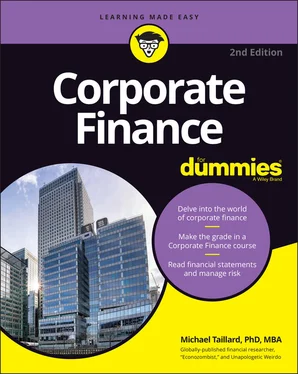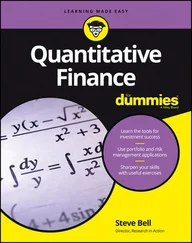Michael Taillard - Corporate Finance For Dummies
Здесь есть возможность читать онлайн «Michael Taillard - Corporate Finance For Dummies» — ознакомительный отрывок электронной книги совершенно бесплатно, а после прочтения отрывка купить полную версию. В некоторых случаях можно слушать аудио, скачать через торрент в формате fb2 и присутствует краткое содержание. Жанр: unrecognised, на английском языке. Описание произведения, (предисловие) а так же отзывы посетителей доступны на портале библиотеки ЛибКат.
- Название:Corporate Finance For Dummies
- Автор:
- Жанр:
- Год:неизвестен
- ISBN:нет данных
- Рейтинг книги:4.5 / 5. Голосов: 2
-
Избранное:Добавить в избранное
- Отзывы:
-
Ваша оценка:
- 100
- 1
- 2
- 3
- 4
- 5
Corporate Finance For Dummies: краткое содержание, описание и аннотация
Предлагаем к чтению аннотацию, описание, краткое содержание или предисловие (зависит от того, что написал сам автор книги «Corporate Finance For Dummies»). Если вы не нашли необходимую информацию о книге — напишите в комментариях, мы постараемся отыскать её.
Corporate Finance For Dummies,
Corporate Finance For Dummies,
Corporate Finance For Dummies — читать онлайн ознакомительный отрывок
Ниже представлен текст книги, разбитый по страницам. Система сохранения места последней прочитанной страницы, позволяет с удобством читать онлайн бесплатно книгу «Corporate Finance For Dummies», без необходимости каждый раз заново искать на чём Вы остановились. Поставьте закладку, и сможете в любой момент перейти на страницу, на которой закончили чтение.
Интервал:
Закладка:
Secured versus unsecured: Secured loans are tied to some asset, which becomes collateral. Basically, you tell the bank that if you fail to pay back your loan, the bank can keep and/or sell that particular asset to get its money back. With unsecured loans, no assets are directly considered to be collateral to which the lender has automatic rights upon the borrower’s default of the loan. However, they can still hurt the credit history of the company, and a lender can still sue to get their money back.
Open-ended versus closed-ended: Closed-ended loans are your standard loans. After your company gets one, it makes periodic payments for a predetermined time period, and then the loan is paid back, and you and the lender are both done. Think of a closed-ended loan like a mortgage, except that it’s not used to buy a house. Open-ended loans are more similar to credit cards. Your company can draw upon an open-ended loan until it reaches a maximum limit, and it just continuously makes payments for as long as it has a balance.
Simple versus compounding interest: Simple interest accrues based only on the principal loan. In other words, if a loan for $100 charges 1 percent interest, the lender will make $1 every period. On the other hand, compounding interest pays interest on interest. So, if the borrower doesn’t make any payments on a loan of $100 with 1 percent interest in the first year, then the loan will charge 1 percent interest on $101 rather than the original $100 the second year. This type of interest is far more common with bank accounts than loans. (Turn to Chapter 9for more on these two types of interest.)
 If a company were to go out of business, any money raised by selling assets will first go to pay lenders.
If a company were to go out of business, any money raised by selling assets will first go to pay lenders.
Schmoozing Investors
Raising money by selling shares of equity is a little more complicated both in theory and in practice than borrowing money using loans. What you are actually doing when you sell equity is selling bits of ownership in a company. Ownership of the company is split up into shares called stock. People only buy stocks when they are excited by the things they hear about them, so your story has to be particularly good when compared to the relatively number-driven world of loans. Although it is illegal to say anything fictional, it is common to share a company’s vision of their future with potential investors, providing a bigger emotional impact.
When you own stock in a company, you own a part of that company equal to the proportion of the number of shares of stock you own compared to the total number of stock shares. For example, if a company has 1,000 shares of stock outstanding (meaning that this is the total number of shares of stock that make up the entire company) and you own one share, then you own 0.1 percent of that company, including any profits or losses it experiences (because profits belong to the owners of the company). So, when you sell equity to raise cash, what you’re really selling are the rights to a certain amount of control over how the company is managed in addition to your rights to the future profits of that company.
Selling stock to the public
When a company is getting ready to go public, meaning it’s opening up the purchase of equity to the public, it must first put all its records and reports in the proper format. The U.S. Securities and Exchange Commission (SEC) requires that all U.S. public companies follow specific criteria for keeping track of financial information and reporting it to the public. The company must also meet a number of accountability requirements and other more minor requirements. In other words, before becoming a corporation, a business must act like a corporation. Often this includes hiring a consultant or an investment banker to help make sure everything is in order. Then, finally, the company can go through the process of becoming established as a corporation and selling stock.
 The easiest way to become a corporation is to go through a full-service investment bank. Often the investment bank can take a company through all the steps, including legally reorganizing the company as a corporation, registering with the proper regulatory authorities, underwriting, and selling stock on the primary market. The legal reorganization process alone is well beyond the scope of this book; I recommend just asking a lawyer.
The easiest way to become a corporation is to go through a full-service investment bank. Often the investment bank can take a company through all the steps, including legally reorganizing the company as a corporation, registering with the proper regulatory authorities, underwriting, and selling stock on the primary market. The legal reorganization process alone is well beyond the scope of this book; I recommend just asking a lawyer.
During the underwriting stage, an underwriter evaluates the value of the company and estimates how much the company needs to raise, how much it should raise, and how much it’s likely to raise. That same person verifies that the company meets all the requirements for being a corporation and selling stock. After that, the company can have its first IPO.
 An IPO, or initial public offering, occurs when a company sells stock to the public. The IPO is when selling stock raises money for the company. After all, the company will use the money that people pay to own stock to purchase things the company needs to operate or expand. The people who buy stock from the company during the IPO make up the primary market because they take part in the initial sale of stock. After the initial stock is sold to the public, it can be resold over and over again, but the company itself doesn’t make any more money. The subsequent selling of stock is just an exchange of ownership between investors for a price negotiated between those same investors. The exchange of stock between investors is called the secondary market; it doesn’t raise any more money for the company.
An IPO, or initial public offering, occurs when a company sells stock to the public. The IPO is when selling stock raises money for the company. After all, the company will use the money that people pay to own stock to purchase things the company needs to operate or expand. The people who buy stock from the company during the IPO make up the primary market because they take part in the initial sale of stock. After the initial stock is sold to the public, it can be resold over and over again, but the company itself doesn’t make any more money. The subsequent selling of stock is just an exchange of ownership between investors for a price negotiated between those same investors. The exchange of stock between investors is called the secondary market; it doesn’t raise any more money for the company.
 Any company, old or new, can have an IPO. All it means is that new stock has been created and registered and is being sold for the first time. If an old corporation decides it wants to raise more money and it thinks investors are willing to pay for more stock, then it can have another IPO to sell new stock that will just add to the total amount of stock the company has on the market.
Any company, old or new, can have an IPO. All it means is that new stock has been created and registered and is being sold for the first time. If an old corporation decides it wants to raise more money and it thinks investors are willing to pay for more stock, then it can have another IPO to sell new stock that will just add to the total amount of stock the company has on the market.
Looking at the different types of stock
Like most aspects of corporate finance, stocks come in many varieties, but no matter which type of stock your corporation has, its value increases or decreases based on the performance of your corporation. Here are three of the main stock types, along with their distinguishing characteristics:
Common stock: If you hold common stock in a corporation, you’re a partial owner, so you get to vote in any decisions regarding company policy, the board of directors, and many other issues. Keep in mind that to be brought to a vote, an issue usually needs to be instigated by one stockholder and then supported by others, at which point a voting form goes out to all stockholders of that company to fill out and return.Holding common stock also gives you rights to a share of dividend payments (profits returned to the company owners) when they’re issued, although this is optional. In case of company liquidation (selling assets after going out of business), common shareholders get whatever value is left over after the lenders and preferred shareholders get what they’re owed. Finally, holding common stock gives you the right to receive specialized reports or analytics from the company.
Читать дальшеИнтервал:
Закладка:
Похожие книги на «Corporate Finance For Dummies»
Представляем Вашему вниманию похожие книги на «Corporate Finance For Dummies» списком для выбора. Мы отобрали схожую по названию и смыслу литературу в надежде предоставить читателям больше вариантов отыскать новые, интересные, ещё непрочитанные произведения.
Обсуждение, отзывы о книге «Corporate Finance For Dummies» и просто собственные мнения читателей. Оставьте ваши комментарии, напишите, что Вы думаете о произведении, его смысле или главных героях. Укажите что конкретно понравилось, а что нет, и почему Вы так считаете.












